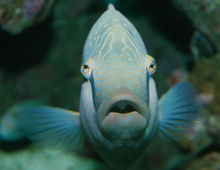Description: Napoleon, Humphead or Maori wrasses are easily recognized by their color, size and shape. They have fleshy lips and a hump over the head that is similar to a “Napoleon” hat. The hump becomes more prominent with age; color varies with sex and age. Males are light green to aqua or purplish blue with blue wiggly-line patterns on the head and front of the body. With age, they also develop a black stripe along their sides. A pair of spiked teeth protrude from the mouth. The somewhat drab females are gray, red or brown.
Size: As the largest member of the wrasse family, they grow up to 7.5 feet (2.29 m) and weigh up to 420 pounds (191 kg).
Behavior: They are rather solitary, living alone or in pairs, Active during the day, they can be seen roving the reef hunting for food, returning at night to a particular cave or under a ledge. If chased by a predator, they dive into their resting place for safety. These gentle, inquisitive giants are often quite friendly with divers.
Diet: These carnivorous fish feed on shellfish, other fish, sea stars, sea urchins and crabs, crushing the shells to get the animal. They can also crush large pieces of dead coral rubble with peg-like teeth to feed on burrowing worms and mussels. Due to their being able to prey on toxic species such as boxfish, sea hares and crown-of- thorns starfish, they are important in the food chain, keeping a healthy and balanced coral reef.
Senses: Since their eyes can turn almost 360°, they have excellent vision.
Communication: Studies have indicated that some larger species such as groupers, Napoleon wrasses and moray eels may assist each other in hunting. This dual hunting involves body language such as side-to-side movement or pointing up or down by movement of the head. It is agreed that the Napoleon is quite intelligent.
Reproduction: Wrasses are born with both male and female sex organs. As protogynous hermaphrodites, they can start their life as a female and then change to the male. They are pelagic spawners, gathering in groups of up to 100 individuals in areas where the fertilized eggs will be carried by the currents. The eggs float in the epipelagic zone (area where enough sunlight enters for photosynthesis to take place or the zone in the open ocean near the surface). After eggs hatch, the larvae float along until they reach a certain size. When large enough, they go down to join other reef creatures. Sexual maturation takes five to seven years.
Habitat/range: Napoleon wrasses live on lagoon reefs and steep outer reef slopes at depths up to 200 feet (61 m). They are found in warm waters of the Pacific Ocean, the Indian Ocean and the Red Sea, mainly on coral reef edges and drop-offs.
Status: Endangered on the IUCN Red List and listed on Appendix II of CITES. Threatened due to their being sought after for their meat, particularly in Asia. The meat of this fish is expensive because it has been overfished and is now quite rare. The huge lips are considered a delicacy, bringing as much as $400 per pair.



